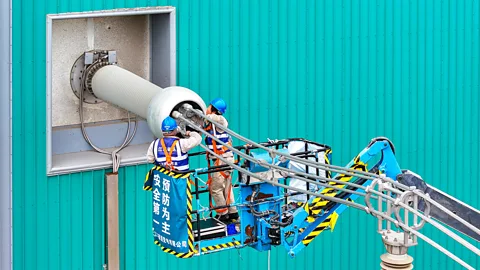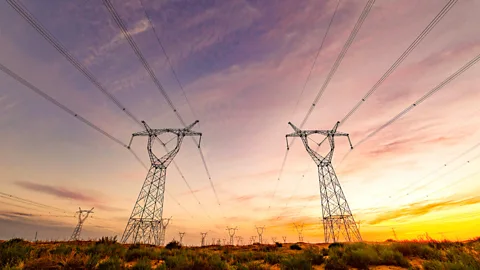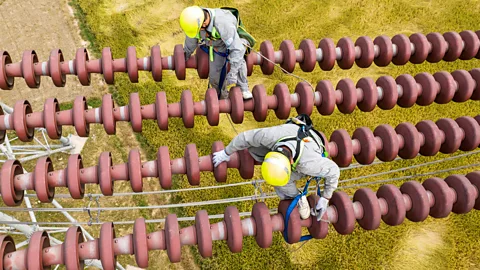Introduction
What if electricity could travel as fast as a bullet train? Sounds futuristic, doesn’t it? In China, this is not just an idea but a reality, thanks to the ultra-high-voltage (UHV) electricity grid. This groundbreaking system is transforming how power is transmitted across vast distances, making energy more accessible, sustainable, and efficient. Curious to know how it all works? Let’s dive in.
Table of Contents
| Sr# | Headings |
|---|---|
| 1 | What Is an Ultra-High-Voltage Grid? |
| 2 | Why Does China Need a UHV Grid? |
| 3 | How UHV Works: A Simple Breakdown |
| 4 | The Bullet Train Analogy: Speed and Efficiency |
| 5 | Benefits of UHV Electricity Grids |
| 6 | Challenges in Implementing UHV Systems |
| 7 | Environmental Impact: A Greener Grid |
| 8 | Global Implications of China’s UHV Grid |
| 9 | UHV and Renewable Energy: A Perfect Match |
| 10 | What’s Next for China’s UHV Network? |
| 11 | How Does UHV Affect Everyday Consumers? |
| 12 | Comparing UHV to Traditional Power Grids |
| 13 | What Can Other Countries Learn from China? |
| 14 | Is UHV the Future of Power Transmission? |
| 15 | Conclusion and Key Takeaways |




1. What Is an Ultra-High-Voltage Grid?
An ultra-high-voltage (UHV) grid is a power transmission system that operates at exceptionally high voltages, typically above 800 kilovolts. This technology allows electricity to travel over long distances with minimal energy loss. Think of it as a superhighway for power, ensuring that electricity reaches far-off regions swiftly and efficiently.
2. Why Does China Need a UHV Grid?
China’s vast geography and uneven distribution of resources make a UHV grid essential. The country’s energy-rich regions, like Inner Mongolia, are far from the energy-hungry cities like Shanghai and Beijing. Without UHV, transmitting electricity across such distances would result in significant losses.
3. How UHV Works: A Simple Breakdown
Imagine squeezing water through a narrow hose—it loses pressure over distance. Now, imagine a wider hose; the water flows faster and farther. UHV works similarly, using higher voltages to “push” electricity across long distances with minimal resistance.
4. The Bullet Train Analogy: Speed and Efficiency
A bullet train connects cities at lightning speed, bypassing traditional slow routes. Similarly, the UHV grid bridges the gap between energy supply and demand with unmatched efficiency. Just as a bullet train transforms transportation, UHV revolutionizes energy transmission.
5. Benefits of UHV Electricity Grids
- Reduced Energy Loss: Higher voltages mean less resistance and fewer losses during transmission.
- Cost-Effective: Transporting energy efficiently saves money for consumers and industries.
- Reliable Supply: Ensures uninterrupted power even in remote areas.
- Supports Renewable Energy: Facilitates integration of solar and wind power into the grid.
6. Challenges in Implementing UHV Systems
While UHV grids are revolutionary, they’re not without challenges:
- High Initial Costs: Building infrastructure requires significant investment.
- Complex Technology: Operating at such high voltages demands advanced equipment and expertise.
- Environmental Concerns: Despite being green, construction disrupts local ecosystems.
7. Environmental Impact: A Greener Grid
One of UHV’s greatest advantages is its role in reducing carbon emissions. By efficiently transmitting renewable energy, it reduces reliance on coal and other polluting sources. It’s like swapping out a gas-guzzler for an electric car on a national scale.
8. Global Implications of China’s UHV Grid
China’s success with UHV has caught the world’s attention. Countries like India and Brazil are exploring similar systems. Could this be the next big thing in global energy?
9. UHV and Renewable Energy: A Perfect Match
Renewable energy sources, like solar farms in deserts or wind turbines offshore, are often far from where the energy is needed. UHV grids are the bridge connecting these sources to urban centers, enabling a sustainable future.
10. What’s Next for China’s UHV Network?
China plans to expand its UHV network even further, aiming to create a national grid that connects every province. This vision aligns with its goals for carbon neutrality by 2060.
11. How Does UHV Affect Everyday Consumers?
For most people, UHV translates to more reliable electricity and potentially lower bills. It’s like upgrading from an old dial-up internet connection to fiber-optic broadband.
12. Comparing UHV to Traditional Power Grids
Traditional power grids are like two-lane roads: functional but slow and congested. UHV grids, in contrast, are highways with multiple lanes, built for speed and efficiency.
13. What Can Other Countries Learn from China?
China’s approach to UHV is a masterclass in innovation and scaling. From securing funding to training skilled technicians, there’s a lot for other nations to emulate.
14. Is UHV the Future of Power Transmission?
As energy demands grow and the world shifts to renewables, UHV grids could become the global standard. They’re not just a technological leap; they’re a necessity for sustainable growth.
15. Conclusion and Key Takeaways
China’s ultra-high-voltage electricity grid is more than a technological marvel; it’s a blueprint for the future. Like a bullet train for power, it connects energy sources to consumers with speed, efficiency, and sustainability. As the world grapples with climate change and growing energy needs, systems like UHV offer a path forward—cleaner, greener, and more efficient.
FAQs
1. What is the primary purpose of an ultra-high-voltage grid?
To transmit electricity over long distances with minimal energy loss, improving efficiency and reliability.
2. How does UHV technology differ from traditional power grids?
UHV operates at much higher voltages, allowing faster and more efficient energy transmission over vast distances.
3. Why is China investing heavily in UHV grids?
China needs UHV grids to connect its energy-rich regions with urban centers and to integrate renewable energy sources into the grid.
4. What are the environmental benefits of UHV grids?
UHV grids reduce carbon emissions by efficiently transmitting renewable energy and decreasing reliance on fossil fuels.
5. Can other countries adopt UHV technology?
Yes, countries like India and Brazil are already exploring UHV systems inspired by China’s success.












